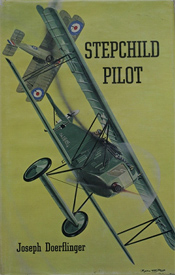|
"This is just unbelievable."
Gilbert George Budwig, Date Unknown (Source: Stanton)
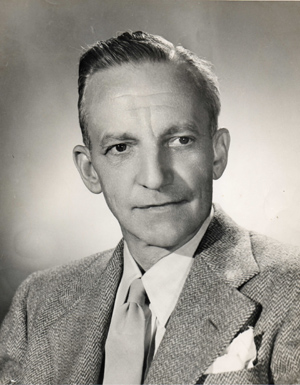 |
Gilbert George Budwig was born November 17, 1895 in Cleveland,
OH. He died February 4, 1978. In between he did
most things in aviation. He learned to fly in 1914 (he's
a member of the Early
Birds of aviation), but information is lacking as to
where and what types of aircraft he learned in. He engaged
in exhibition and passenger transport for a short time, then
gave up flying.
He resumed flying at the beginning of WWI and entered the
Buffalo, NY Curtiss Flying School in 1916. He became a civilian
military flying instructor and, during WWI, served at Chanute,
Kelly, Rockwell and March Fields.
Budwig had a short career as an airmail
pilot from April
1, to May 24, 1919, testing new planes and flying the New
York to Chicago route. An incident cited in a New York Herald of April 7, 1919 probably explains why his career was short. The headline reads:
"MAIL FLYER LANDS UPSIDE DOWN BUT EMERGES UNHURT".
He was testing a
Haviland-Ford aircraft and departed Belmont Park in the
late morning. The article goes on to cite engine failure as the
cause of a downward glide from 2,000 feet. He landed in farmland
near Hempstead, LI, NY. The airplane turned turtle, but he
was not injured. Rather, he was found smoking a cigarette
when "rescuers" arrived.
Later in 1919 he co-founded the Queens Aerial Transportation
Company with two other ex-airmail pilots at the Queens Village
Airport, Queens, NY. The new firm gave flight instruction,
performed aerial advertising, offered exhibitions and carried
passengers.
Budwig in Flight Suit, Date & Location Unknown (Source: Stanton)
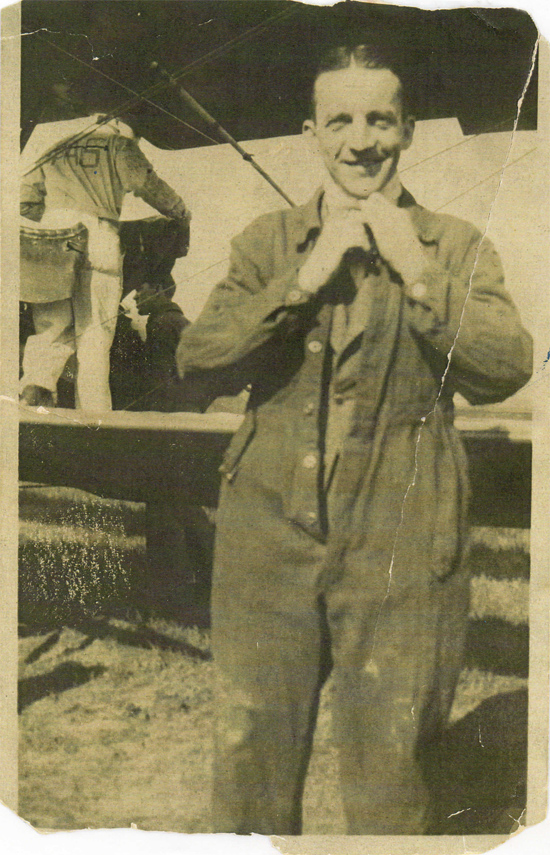 |
He moved to California in early 1920 and operated a passenger
carrying business out of Venice. With Fred D. Hoyt he formed
the Hoyt-Budwig Company at the Venice Airport doing commercial
flying and flight testing for local aircraft firms.
G.G. Budwig ca. 1940
(Source: NASM Biographical File)
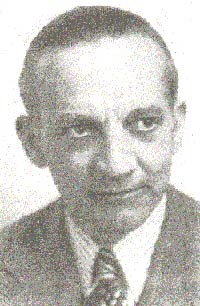 |
In February 1920 he was involved in the budding movie business
that was embracing aviation plot lines. As such, he perfected,
with other movie pilot notables (e.g. Hoyt, Art Goebel, Al
Wilson), transfers
of stuntmen from aircraft to aircraft, and controlled crashes
and aerobatics.
In May
1920 he conducted flight tests of the new Lockheed Model
S-1 sport plane. In September he became the personal pilot
for Los Angeles banker L.C. Brand. He flew Brand on numerous
tours of the west and southwest. He remained Brand's personal
pilot until 1924 when he started the Budwig Radio Company
at Glendale, CA.
In 1927 he became
Director of Air Regulation, U.S. Department of Commerce (DOC) in
Washington, DC until 1933. He came to Tucson twice as pilot in command, on October 28, 1928
and October 24, 1931. Both times he was flying Department of Commerce
aircraft, NS-15 (please click to see an image on this site
of this airplane), a Ryan, and NS-2, a Stearman. He carried
a single passenger each time. Based in Washington, DC, their
itineraries covered the southern route from El Paso, TX to Los
Angeles, CA. He also landed once as a passenger with Howard Rough, see below.
In the early 30s, at his post with the DOC,
his greatest achievement was the framing and
promulgation of the Scheduled Air Transport Rating, SATR,
required of all pilots flying scheduled operations as of
January 1933. Budwig's own transport license was #39.
Below, a group image of Department of Commerce staff. I have displayed it vertically, because it is a panorama that would lose much detail if displayed horizontally. Notice the list of people in the upper left corner. Gilbert Budwig is in the front row, center, as would represent his status as Director of Air Regulation. As is my practice, no attempt was made to modify this photograph. You are seeing it just as it comes from donor Stanton's (right sidebar) collection.
Although the date and location of the image are unidentified (probably Washington, DC; ca. late 1920s-early 1930s), there are several people represented here that, besides Budwig, were pilots or passengers who signed the Davis-Monthan Register.
For example, in the rear row, Sanford L. "Sandy" Willets appears in the Register twice as a passenger, once with Walter Parkin flying the DOC Buhl NS-4 on August 30, 1927, the other time on January 9, 1928. Walter Parkin is a pilot as well as passenger, landing as the latter on April 19, 1927. Howard Rough landed as pilot on October 1, 1928 carrying Budwig as passenger in the DOC Pitcairn PA-6, NS-20. H.B. "Beans" Pentland is a pilot who visited Tucson August 22, 1929 flying a Navy airplane, A-6891. Monte Mouton signed the Register between May 2-May 5, 1933 flying NS-36. Usually they identified themselves in the Register as DOC employees, and usually they were flying in "NS"-prefixed airplanes owned by the government.
Department of Commerce Group, Date & Location Unknown (Source: Stanton)
 |
For people googling their ancestors, here is a listing of the people in the photograph so the search engines can find them: Bob Hazen, Sanford L. "Sandy" Willets, Joe Marriott, Ernie Cutrell, Fiske Marshall, Len Jurden, George Gardner, Edison "Monte" Mouton, Walt Parkin, George Vest, Buck Rowe, Chet Charles, CMW, GGB, Howard Rough, Leo Wilson and H.B. "Beans" Pentland. Does anyone KNOW who "CMW" is?
Below, shared with us by site visitor Jeff Staines, is a U.S. airmail postal cachet dated November 11, 1928. Mr. Staines says about his cachet, "He was at the dedication of the Major John T. Fancher Memorial Beacon at Wenatchee, Washington. John Fancher died as a result of an explosion caused by a "dud" which he used in an aerial show. Fancher Beacon is still in use today. Wenatchee was the sight of the Herndon-Pangborn landing site after their historic flight.
U.S. Airmail Postal Cachet, November 11, 1928 (Source: Staines)
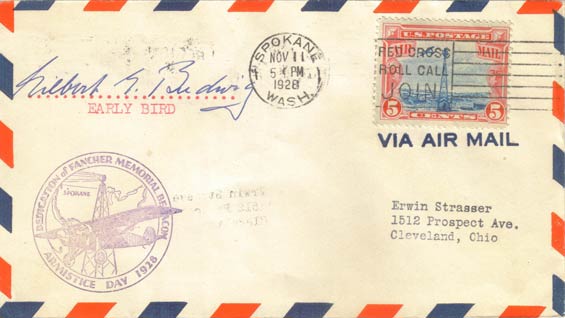 |
Thus, this cachet is not associated with Budwig's earlier work as an airmail pilot. Rather, he signed this envelope as an Early Bird during his official DOC duties at the beacon dedication ceremony.
Below, a congratulatory letter to Budwig from his friend William Waterhouse (not a Register signer; none of the letter signatories are Register people). This letter was probably directed toward one of his promotions at the U.S. DOC.
Waterhouse Letter, October 18, 1929 (Source: Stanton)
 |
To continue, realizing the value of blind flight training, after months
of preparation, Budwig announced in the summer of 1932 that every
one of the 600 transport pilots at the time would have to
qualify under the requirements of the new SATR. This necessitated
spending thousands of dollars by transport companies for
equipping training planes and an average of about 17 hours
in the air to train each of the pilots. He was probably not very popular among pilots and airline companies.
Although one of the
most drastic regulations to-date, the foresighted, efficacy and safety promulgation of the instrument proficiency rule has been proven
over and over through to the present day. To understand
how closely Budwig's decision followed the very first solo
instrument flight, please visit this page for Davis-Monthan
pilot Albert Hegenberger. We should not be surprised, given the high achievements of many of our Register pilots, that one of our own, Hegenberger, was the very first to fly an entirely instrument-guided flight in May, 1932.
All 21st century
air transport pilots must be rated to fly under instrument
conditions. As such, they have demonstrated the ability to fly from point A to point B
by reference solely to navigational instruments in the aircraft,
with no assumption of being able to see the ground, a horizon, or anything
else around the airplane. Try that some time.
In 1933 he left the DOC and formed the Budwig Manufacturing
Company to manufacture horticultural equipment. In 1940 he
became President of Aircraft Components, Inc., manufacturers
of stainless steel and aluminum sheet metal aircraft component
parts.
Besides his government and entrepreneurial work, he was also in the military for 23 years. He was a reserve Captain in the US Army from 1929-1932, as well as reserve officer in the US Marine Corps from 1932 until retirement in 1955 as a Lt. Colonel.
Below, an article from the Lockheed aircraft internal newspaper documenting a 1972 visit by Budwig, Anthony Stadlman and Norman Hall.
Lockheed Star, June 15, 1972 (Source Stanton)
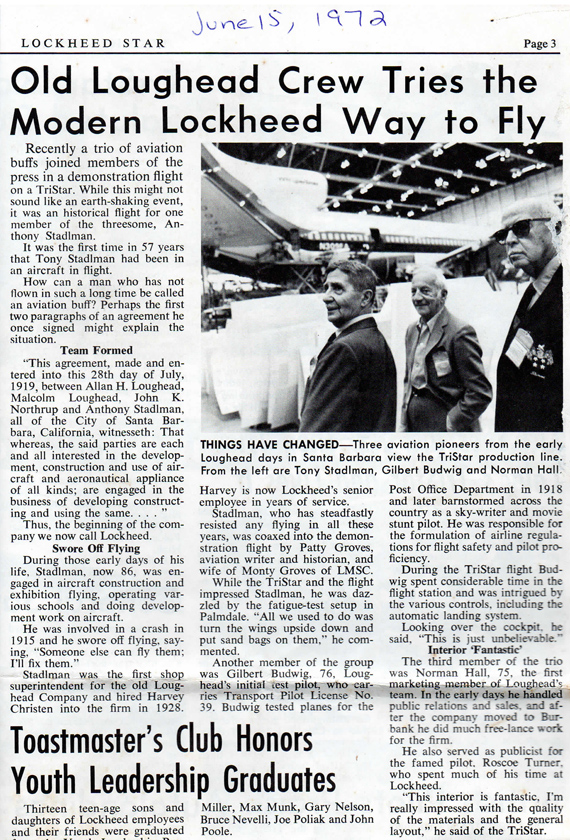 |
Below, Budwig (center) with Hall (left) and Stadlman. Norman Hall is among the passenger listings in the Davis-Monthan Airfield Register. He landed Monday October 29, 1928 with pilot E.L. Remelin. They were flying in Lockheed Vega NC7805. His fellow passenger was Allan Lockheed.
G.G. Budwig (C) With Anthony Stadlman (R) and Norman Hall (Source: Stanton)
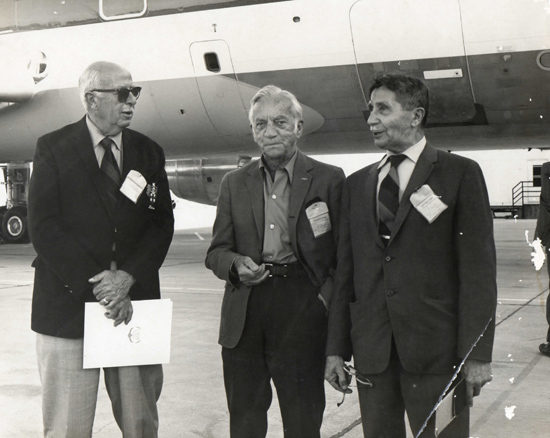 |
Budwig retired to Ramona, CA and applied for military retirement benefits on November 17, 1955. Below, his application for those benefits.
Application for Retirement Benefits, 1955 (Source: Stanton)
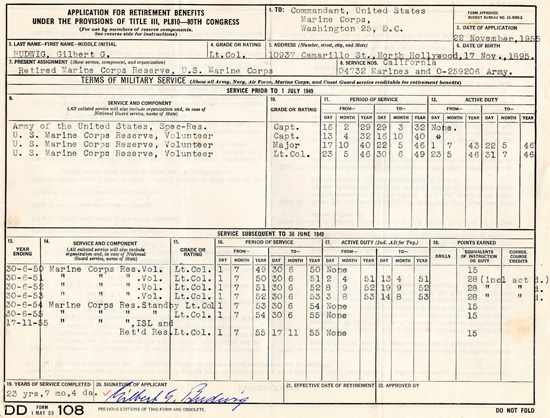 |
He was retired for 23 years. Below, his death certificate. He flew West February 4, 1978 of complications from lung cancer, a fate we could have predicted from his earlier airmail accident where he was found casually smoking a cigarette back in 1919.
G.G. Budwig Death Certificate, February 4, 1978, (Source: Stanton)
 |
---o0o---
During the early 1930s, probably due to his role as Director of Air Regulation for the DOC, Budwig received several postal cachets commemorating first airmail flights. Below, two cachets from November, 1930 celebrating the first flights from Miami to French Guiana and Brazil.
Airmail Cachet, November 8, 1930 (Source: Stanton)
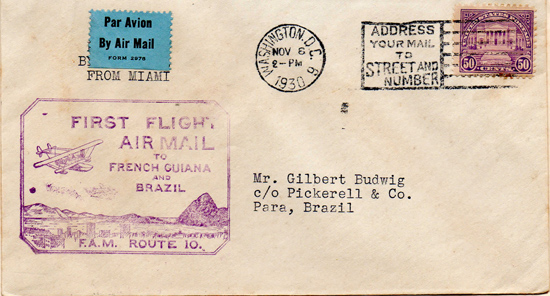 |
Airmail Cachet, November 21, 1930 (Source: Stanton)
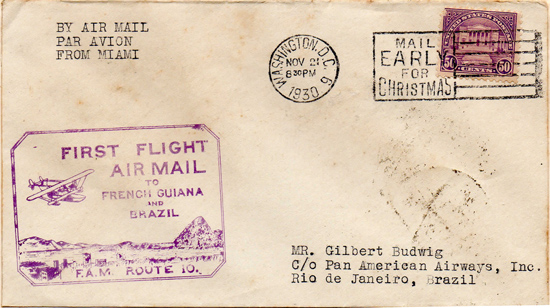 |
Below, a cachet celebrating the first airmail flight across Lake Michigan, March 2, 1933.
Airmail Cachet, March 2, 1933 (Source: Stanton)
 |
Pilot Signature, March 2, 1933 (Source: Stanton)
 |
Note that this last envelope was signed by the pilot of that first flight. Joseph Doerflinger.
Thanks to Mike Gerow for identifying pilot Doerflinger and sending the book cover art, right, and article below, published in the Sheboygan Journal, Sheboygan, WI, October 23, 1970. There we have pilot Doerflinger's obituary and learn that he was a fighter pilot during WWI.
Joseph Doerflinger Obituary, Sheboygan Journal, 10/23/70
(Source: Gerow)
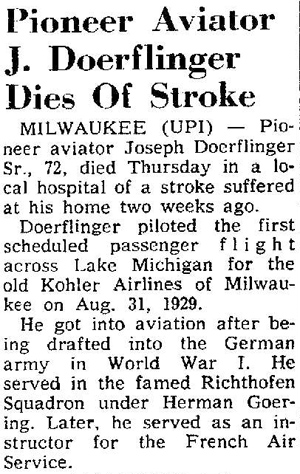 |
Interestingly, the article states he flew the first passenger route across Lake Michigan in August, 1929, almost four years before the airmail flight.
Regardless of whether mail or passengers are carried, today there are over a dozen major low-level air routes (called Victor Airways) across Lake Michigan. They are used alike by commercial and general aviation pilots on a regular basis, during fair weather or foul, for business and for pleasure.
Doerflinger's military service history was also remarkable. During WWI, he flew with the Red Baron (Manfred von Richthofen), and with Hermann Goering, soon to be Adolph Hitler's right hand during WWII.
Doerflinger was also an author, who published "Stepchild Pilot" in 1959 (right sidebar), 11 years before he passed away.
---o0o---
Dossier 2.1.59
UPLOADED: 03/12/06 REVISED: 02/17/07, 11/25/07, 01/24/09, 03/11/10, 05/30/12, 12/18/21
|

















